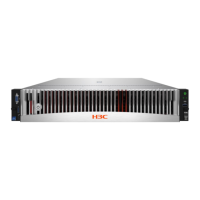2
http://www.h3c.com/en/home/qr/default.htm?id=66. You can query the memory frequency by
selecting Memory Module and query the maximum supported memory frequency by selecting
Processor.
The actual operating memory frequency is equal to the lesser of the memory frequency or the
maximum memory frequency supported by the processors. For example, if the memory frequency is
4400 MHz and the maximum memory frequency supported by processors is 4800 MHz, the actual
operating memory frequency is 4400 MHz.
The number of DIMMs per channel (1DPC or 2DPC) can affect the operating DIMM frequency. For
more information, see Table 32.
Table 32 Operating DIMM frequency with different DPC configuration
CPU type
DPC configuration
Sapphire Rapids 4800MHz
1 DPC 4800 MHz
2 DPC 4400 MHz
Installation guidelines
When you install only DDR5 DIMMs, follow these restrictions and guidelines:
• Make sure their corresponding processors are present before powering on the server.
• As a best practice, install DDR5 DIMMs that have the same product code and DIMM
specification (type, capacity, rank, and frequency). For information about DIMM product codes,
use the component compatibility lookup tool at
http://www.h3c.com/en/home/qr/default.htm?id=66. To install components or replace faulty
DIMMs of other specifications, contact Technical Support.
• For the configured memory mode to take effect, make sure the following installation
requirements are met:
DIMM population requirements
Independent
• If one processor is present, see Figure 70.
• If two processors are present, see Figure 71 and Figure 72.
Mirror
• If one processor is present, this mode is supported only when 8 DIMMs or 16
DIMMs are installed. For more information, see Figure 70.
• If two processors are present, this mode is supported only when 16 DIMMs or
32 DIMMs are installed. For more information, see Figure 71 and Figure 72.
If the DIMM configuration does not meet the requirements for the configured memory mode, the
system uses the default memory mode (Independent mode).
In Figure 70, Figure 71, and Figure 72, the black DIMM slots (for example, the D1 slot) are grey
colored, and the white DIMM slots (for example, the D0 slot) are not colored.

